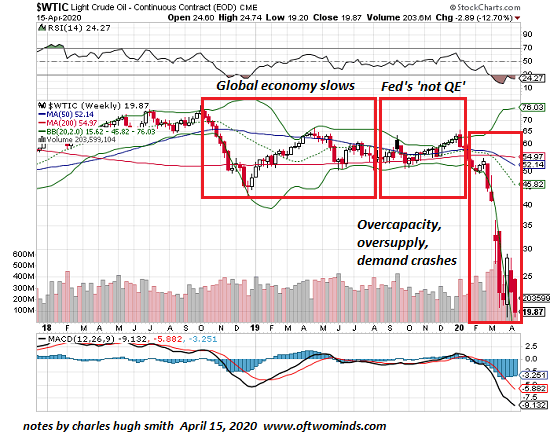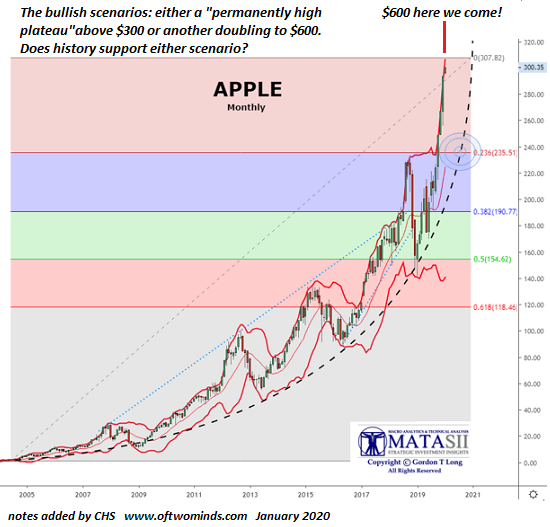The price of a great many assets will crash, out of proportion to the decline in demand. Oil is the poster child of the forces driving massive deflation: overcapacity / oversupply and a collapse in demand. Overcapacity / oversupply and a collapse in demand are not limited to the crude oil market; rather, they are the dominant realities in the global economy. Yes, there are shortages in a few high-demand areas such as PPE (personal protective equipment), but across the entire spectrum of global supply and demand, there is nothing but a vast sea of overcapacity / oversupply and a systemic decline in demand as far as the eye can see. Here’s a partial list of commodities that are in Overcapacity / oversupply: 1. Overvalued assets 2. Overpriced income streams (as
Topics:
Charles Hugh Smith considers the following as important: 5.) Charles Hugh Smith, 5) Global Macro, Featured, newsletter
This could be interesting, too:
Nachrichten Ticker - www.finanzen.ch writes Die Performance der Kryptowährungen in KW 9: Das hat sich bei Bitcoin, Ether & Co. getan
Nachrichten Ticker - www.finanzen.ch writes Wer verbirgt sich hinter der Ethereum-Technologie?
Martin Hartmann writes Eine Analyse nach den Lehren von Milton Friedman
Marc Chandler writes March 2025 Monthly
The price of a great many assets will crash, out of proportion to the decline in demand.
Oil is the poster child of the forces driving massive deflation: overcapacity / oversupply and a collapse in demand. Overcapacity / oversupply and a collapse in demand are not limited to the crude oil market; rather, they are the dominant realities in the global economy.
Yes, there are shortages in a few high-demand areas such as PPE (personal protective equipment), but across the entire spectrum of global supply and demand, there is nothing but a vast sea of overcapacity / oversupply and a systemic decline in demand as far as the eye can see.
Here’s a partial list of commodities that are in Overcapacity / oversupply:
1. Overvalued assets
2. Overpriced income streams (as income craters, so will the asset generating the income)
3. Labor: low-skill everywhere, high-skill in sectors experiencing systemic collapse in demand
4. AirBnB and other vacation rental properties
5. Overpriced flats, condos and houses
6. Overpriced rental apartments
7. Overpriced commercial office space
8. Overpriced retail space
9. Overpriced used vehicles
10. Overpriced collectibles
I think you get the idea.
Should China restart its export factories, then almost everything being manufactured will immediately be in oversupply, as the global export sector was plagued with mass overcapacity long before the Covid-19 pandemic crushed demand.
Incomes will crater as revenues and profits crash, small businesses close their doors, never to re-open, local governments tighten spending, and whatever competition still exists will relentlessly push the price of labor, goods and services lower.
Globalization has generated hyper-specialization in local and regional economies, stripping them of resilience. Fully exposed to the demand flows of a globalized class of consumers with surplus discretionary income, regions specialized in tourism, manufacturing, commodity mining, etc.
All these regions are now facing a structural collapse of global demand, and they have no diversified local economy to cushion the blow to jobs, incomes, profits and tax revenues.
Thousands of small business that could barely squeak through a 20% decline in revenues are facing a 50% or more decline as far as the eye can see. With costs such as rent, labor, fees, taxes and healthcare at nosebleed levels, an enormously consequential number of small businesses globally cannot survive more than a modest, brief drop in revenues, as their costs remain high even as their sales plummet: costs are sticky, profits slide quickly to zero and beyond.
What’s scarce:
1. low-risk, high-yield assets
2. Low-cost hedges against the collapse of asset valuations
3. Investment income streams that survive the collapse of demand and asset valuations
Here is a weekly chart of crude oil (WTIC). Note the weakening of price as the global economy slowed in 2018-2019, the modest rise as the Federal Reserve began “not QE” printing of currency in September 2019, and the complete collapse as oil producers jockeyed for control via crushing price wars/over-production and global demand plummeted.
|
This is the future of vast swaths of the global economy: labor, commodities, assets, goods and services, and the tax revenues that are skimmed from the private sector, will all crash as supply far exceeds demand. The price of a great many assets will crash, out of proportion to the decline in demand. Only the global top 10% can afford to buy pricey vacation homes, for example, and as the top 10% own 90% of the assets that are melting away like ice cubes in Death Valley, when their ability and willingness to buy assets they can no longer afford vanishes, the market price of those assets can fall 90% or even to zero. You’ll know this moment has arrived when you see once-expensive sailboats and pleasure craft abandoned and drifting, as the owners can no longer afford the dock fees and can’t sell the craft. To quote Jackson Browne: Don’t think it won’t happen just because it hasn’t happened yet. |
Light Crude Oil, 2018-2020 |
Tags: Featured,newsletter









